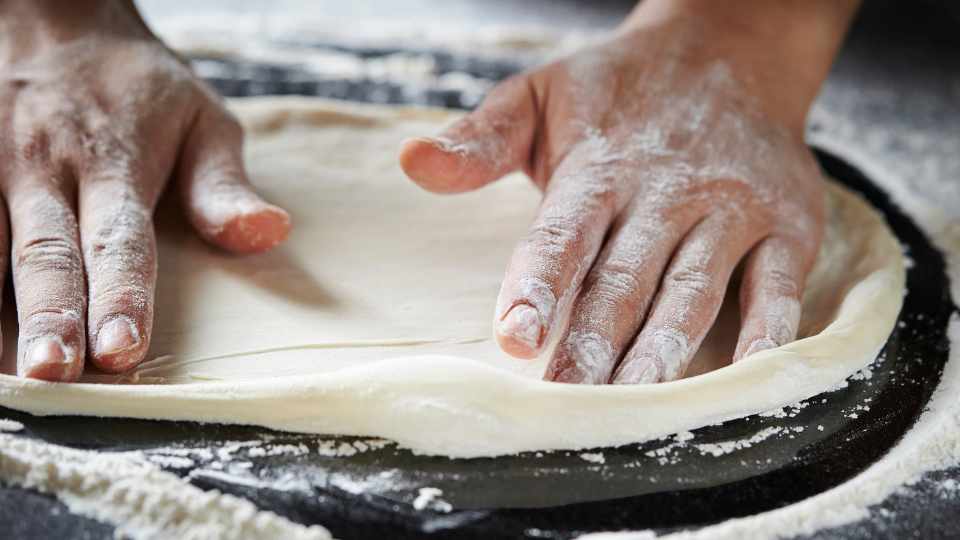How to Shape Pizza Dough the Right Way
Tired of soggy, unappetizing pizza crusts that don’t hold up in the oven? Let’s make a change! Transform yourself into an expert dough shaper with just a few simple steps.
Now you can whip up delicious homemade pizzas from your own kitchen – whether it be traditional Neopolitan style or focaccia bread. So tie on an apron and get ready to craft some culinary masterpieces; it’s time to say hello to restaurant-quality pizza creations.
How to Shape Pizza Dough – A Step-by-step Guide

Conquering the art of pizza dough shaping doesn’t have to be intimidating – with some simple instructions, you will become a pro in no time! Here is an easy-to-follow guide that guarantees your success in creating delicious and perfectly shaped pizzas.
Step 1: Bring the dough to room temperature
Prior to forming your homemade pizza, the dough needs to be brought up to room temperature. Doing this will relax the gluten strands, enabling you to stretch and shape them with ease. Letting the dough stand out of its refrigerated environment for 30 minutes should do just that.
Step 2: Prepare your workspace
To ensure you don’t deal with any sticky situations, prepare your area for success by rubbing a generous amount of olive oil over the workspace. This will help to prevent the dough from sticking and make it easier to slide around as you work on it. Additionally, line a pizza peel with parchment paper or cornmeal for an extra layer of protection against stickiness.
Step 3: Press the dough into a disc
Now it’s time to transform your dough into a disc. Place the ball of pizza dough onto your workspace and press down on it with the heel of your hand, rotating around until you get a circle that resembles an oversized pancake. Keep pressing until you achieve this shape.
Step 4: Use gravity to stretch the dough
Now comes the exciting part – let’s shape the dough! Put it onto your hands, and keep your fingers tucked underneath. Then carefully stretch it by turning them in a clockwise or anti-clockwise manner, gently tugging with gravity as you go. Make sure to rotate the dough regularly for an even finish when you’re done.
Step 5: Aim for a 10-inch-wide circle
Aim for a ten-inch even circle that’s about one-third of an inch in thickness. Ensure you have enough room to set your pizza on the peel before stretching the dough too thinly; if it tears, patch any gaps or adjust its shape by pinching it.
To make sure the pizza is prepared correctly, shake the peel lightly to ensure that the cornmeal adequately prevents sticking. If parchment paper was utilized for your pizza creation, you can slide it directly onto your stone oven.
Congratulations! Your pizza is ready to be topped before you place it into the oven for a delicious homemade pie. With some practice and dedication, your dough-shaping skills will improve in no time, making you an incredible pro at crafting pizzas.
Why does my pizza dough tear when shaping?
All the blame for this annoying issue lies with incomplete gluten development. Gluten, a protein in wheat flour, is what gives your dough its springiness and support. As you knead the dough, these gluten strings become firmer which assists it to keep its shape during rising.
However, if you shortchange your dough in the kneading or rising process, it may not form enough gluten strands to give it structural strength and make shaping easier. Moreover, low-protein flours often don’t develop sufficient gluten no matter how much you knead them. As a result, your dough may be weak and prone to tearing when handled.
To keep your dough from tearing and bouncing back into a ball as you stretch it, make sure to knead thoroughly for enough time and give the dough ample opportunity to rise.
In addition, using high-protein flour will ensure that strong gluten strands form in order to provide structure and texture. With these practices in place, you should be able to easily shape your dough while avoiding tears or weak points.
How long to let pizza dough rise after shaping?
After your pizza dough has had enough time to rise, it’s now ready for you to get creative.
Begin by lightly coating both your workspace and hands with flour before pressing and stretching the dough into whatever shape you desire – whether that be a traditional circle or something more unique!
As you form the crust, make sure there is no spot too thick or thin so everyone gets an even slice when they’re done baking. Once everything is set in place, transfer it over to either a baking sheet or stone of your choice.
After you’ve shaped your pizza dough, the next step is to let it rise – but for how long? It really all comes down to personal preference. For a thin and crispy crust, 10-15 minutes will do; yet if a thicker and chewier texture is what you’re after, 30-45 minutes should be just right.
Keep an eye on the progress of your dough while also using your best judgment – give it enough time so that the crust has an ideal consistency without becoming too airy or floppy when adding toppings later. Have fun crafting that perfect pie.
Should I poke holes in my pizza dough?
If you’ve been looking for the secret to crafting a magnificent homemade pizza, then look no further! The answer lies in poking holes into your dough. A dinner fork is perfect for creating these tiny perforations and will result in an extraordinarily crunchy crust that your family won’t soon forget.
Strategically poking holes in the dough creates little openings that permit air to escape while your pizza is baking. This prevents an undesirable puffing of the pizza dough, avoiding unwanted bubbles and preserving a superior texture for your final product.
Additionally, perforations in the crust make it easier for the pizza sauce to spread all over, allowing a more even flavour distribution with every bite. This also ensures that no part of your dish is soggy and undercooked since the sauce can reach out to each corner of your scrumptious pizza!
Conclusion
To put it simply, crafting pizza dough doesn’t have to be a daunting task. With the right instructions and some practice, you can become an expert in this culinary art.
Just remember these simple steps outlined above – with patience and dedication, you will soon master homemade pies that are tastier than anything from a restaurant. So don’t hesitate – tie your apron on tight and let’s get cooking delicious pizzas from the comfort of your home!






